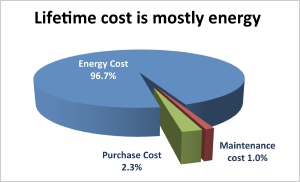The importance of post-occupancy commissioning

With recent annual energy price rises of upwards of 10%, Matt Ward of the Commissioning Specialists’ Association outlines the rising demand for aftercare and fine tuning of building services.
With the ever-increasing rise in energy costs, we are witnessing the fastest period of evolution of the commissioning process as it gains increasing recognition as more than just a single set of activities proving plant capabilities, crowbarred into the final few weeks of a project prior to handover.
As mentioned at BSRIA’s Annual Briefing recently, it is the cost of energy and predicted limits to available supply that is driving the change in thinking within construction rather than the reduction of emissions, as end users factor in whole-lifecycle costs in more detail. Of the more notable changes, the advent of BREEAM (including credits for seasonal commissioning) and BSRIA’s Soft Landings Framework (incorporating continuous commissioning) place a great deal of emphasis on the commissioning process whilst extending the traditional responsibilities of commissioning practitioners.
BREEAM itself has evolved over recent years and has now been enshrined within statute (via planning permissions) within the City of London, whereby all new City buildings are expected to achieve the ‘Excellent’ rating upon occupation. To achieve the ‘Excellent’ rating it must now be proven that the original approved design intent has been realised upon handover.
BSRIA’s Soft Landings Framework complements BREEAM in many ways and in many instances goes hand in hand. However, it focuses more on the occupants, usage and aftercare rather than the delivery of approved design concept. These approaches are combining well in developing a real cultural shift in planning and managing the construction process, whilst extending the responsibilities of those who understand the building beyond handover into the aftercare period. The potential energy and capital savings from a well planned and executed commissioning process are finally being realised and, in doing so, are enhancing the reputation of those who choose to embrace this change — from developers to construction professionals alike.
As previously mentioned there is a real risk of energy shortages as the electricity capacity assessment conducted by OFGEM In 2012 indicated that ‘there will be a significant reduction in electricity supplies as estimated margins decline from around 14% to 4% by 2015/2016’. The requirements, therefore, to satisfy BREEAM are likely to become increasingly refined, whilst the demands to squeeze the most efficient capabilities from plant increase.
 |
| A huge proportion of the lifetime cost of a building is due to energy, which is where continuous commissioning can achieve significant savings. (Chart courtesy of Gambica) |
Where lifetime costs are correctly factored into building-services design, supplemented with continuous commissioning conducted throughout the opening periods of occupancy, significant savings over the traditional build process are gained. For example, comparing the initial capital outlay for an item of plant to the overall cost of energy to run that item of plant really puts into perspective where our efforts should be focused.
With dwindling resources, efficiency is a major factor, which is where commissioning practitioners come into their own. With the full support of an educated project team supplementing a rigorous design, coupled with a concise commissioning plan, programme and logic sequence, the commissioning process would be executed with sufficient time and resource to deliver extremely efficient building services.
Furthermore, unlike the traditional culture of commissioning by proving plant capabilities, balancing to design parameters, proving functionality and then walking away, further onus is now assigned to commissioning practitioners to ensure that the building works efficiently with the way the users interact with it.
Formula 1 engineers design and build a new car every year or so, but only when the driver starts using it can the potential be unlocked. Huge amounts of data are collected and analysed regarding how he uses it within the local environment.
Utilising this essential information, coupled with the driver’s actual feedback, the car is then finely tuned to produce the most efficient responses to the user interface and external conditions, with the results for the most successful teams being enhanced reputations and capital gains.
Sounds familiar? Well it should be, as these are just some of the solutions that are being applied via BSRIA’s Soft Landings Framework.
The technology is available to monitor and collect vast amounts of data regarding the performance of buildings. Again, couple this with occupancy feedback (via independent post-occupancy surveys) and analyse to understand how to improve performance and efficiencies to enhance the occupants experience whilst reducing energy usage and lifecycle costs.
The opportunity therefore exists for commissioning practitioners (both controls and mechanical) to maintain a level of input throughout the aftercare period to ensure a smooth transition and impartation of their knowledge and experience of the project whilst fine tuning the building to unlock its potential.
Matt Ward is chairman of the Commissioning Specialists Association and managing director of Prime Environmental Services







